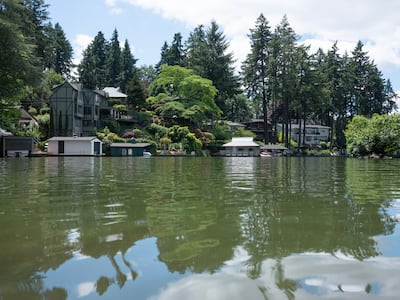Ranger Taylor stands at the gateway to Oswego Lake and welcomes visitors to the future. He wants them to wear a life jacket.
The Lake Oswego city parks department has stationed Ranger Taylor at the top of four concrete steps that lead down to the green water of Lakewood Bay. The steps in Lower Millennium Park used to feature metal signs reading “Private Lake.” Now they don’t. Instead, there is Ranger Taylor, assigned by the city to 10-hour shifts at the water’s edge.
He’s dressed in long green pants and a khaki shirt, and carries a ring of keys. He wanders between groups of people carrying kayaks and paddleboards to the water. Ranger Taylor tells them the Oregon Marine Board rules for boating: Carry a whistle or an airhorn. Stay between the shore and the buoys. And put on a life jacket.
“Please don’t go in the center of the lake,” he says. “Just giving you folks a heads-up.”
Ranger Taylor has dozens of these conversations on a hot Sunday afternoon. It’s the same routine he’s had every Thursday through Sunday since May. That’s when the city created his gig, two months after a Clackamas County circuit judge ruled that Oswego Lake must be open to the public, not just people who own shoreline property.

The lake is ringed by mansions, and the steps of Lower Millennium Park—squeezed between railroad tracks and the Lakeshore Inn, lined by reeds and a family of ducks—mark the only spot where the public may launch a vessel. All day long, Ranger Taylor tells them how to do so safely.
But Ranger Taylor is not authorized to speak to the press. He doesn’t want to get in trouble, so he won’t give quotes and doesn’t offer his full name. Most of all, he won’t confirm how many newcomers are floating on Oswego Lake each day.
It’s not some big secret. Lake Oswego’s deputy city manager later says that on this Sunday, 126 people visited the park, and 71 went in the water. But the city is being cautious about who gives out that information.
Such is the new normal on Oregon’s most notorious once-private, now-public lake, where the water is open but lips are sealed. Since Judge Kathie Steele issued her ruling March 3, this town of 40,000 people has churned with PVC watercraft and hard feelings. Even the city’s recent decision to close lake entry for Independence Day weekend brought TV cameras and legal threats aimed at soiling Oswegans’ oasis. The barbarians are at the docks.
Or maybe not. Many of the people entering the lake this Sunday are actually residents of Lake Oswego. (The town and the body of water share a name, but the order of words is different.) Longtime residents are finally casting off into a civic asset that used to be exclusively enjoyed by their more affluent neighbors.
“If you ask anyone who lives on the lake, they’re going to say no,” says Eric Brody, who lives in town but never had lake access. “If you ask the rest of us, we’re going to say, why shouldn’t other people be able to use it?”
In fact, if people who live on the lake are bothered by sharing the water for the first time since 1942, they’re too savvy to say so. More attention is the last thing Lake Oswego needs now. Another headline would only provoke Portland wiseacres to issue online threats of lakeshore keggers.
Tara Forseth is one of the few naysayers who will speak on the record. She owns a home in the town’s Palisades neighborhood—when she bought the house, she thought it came with lake access, but it didn’t. No matter: She still thinks opening the water will increase car traffic on her suburban streets.
“I just don’t care so much for other people from other cities coming into our nice, quiet community,” Forseth says. “I understand that it’s fair. If I didn’t live here, I’d like it to be public.”
A few feet away, her husband looks warily over Lakewood Bay, which at the moment has three people in it. Another man walks up to him and points to new arrivals carrying kayaks: “Isn’t this great?”
“No,” he replies. “Not really.”

In Lake Oswego, America’s birthday is a big boat party. In years past, the city has offered the public a pancake breakfast, a parade through town, a festival with a pie-eating contest, and a laser show. If you lived on the 2.9-mile-long lake, the festivities would multiply. The Lake Oswego Corporation, or Lake Corporation for short, regularly hosted a ski and wakeboard extravaganza in Lakewood Bay, but most of the action happened on the main lake, separated from the bay by a narrow channel. There, a rock band played from a floating barge. Fireworks, shot from the barge, showered down on residents watching from paddleboards. That was also a production of the Lake Oswego Corporation.
What’s the Lake Oswego Corporation, you ask? It’s basically a homeowners association that decides who qualifies for one of the 3,000 easements that allow property owners to embark on the water.
“Access to an easement on Oswego Lake is a privilege, not a right,” the Lake Corporation explains on its website. In its rulebook, the corporation further explains that the Oregon Iron and Steel Company deeded it the lakebed in 1942, with a mandate that it “must preserve the lake for all time for the benefit of property owners with lake access privileges.” Homeowners pay $219 a year for swimming privileges, and $1,498 to launch a power boat.
The Lake Corporation’s board president declined to comment for this story, or to make any other board members available for an interview. “Trust will need to be built before we comment,” he said in an email.
The Lake Corporation obtained an Oregon Marine Board permit April 8 for this year’s fireworks show. Soon after, things went awry. KGW-TV first reported last month that the city parks department was planning to close the lake to the public from July 3 through 7. Most TV stations picked up the story: Oswego Lake, private again!

City officials say the Lake Corporation never asked for a holiday closure, and that the decision is intended to let police and firefighters focus on traffic control, fireworks injuries, and the usual tumult that comes with hosting a pancake breakfast and a laser show. “The Independence Day weekend is already an ‘all hands-on-deck’ effort for city operations, prior to the judge’s ruling,” writes deputy city manager Madison Thesing.
But the PR damage was done. The Twin Cinema, a reliable barometer of local sentiment, posted on its marquee: “Open to the public on the Fourth of July unlike the lake, apparently.” It didn’t take long for Redditors to begin brainstorming ways to crash the party.
A representative sampling of comments:
“Me and my mullet crew are comin’ with cases of Coors Light and boom boxes. It’s gonna be so rad! USA!”
“Lmao I live in Lake O and I hope we flood the lake with anyone who doesn’t live here. I hate this city lol.”
“Épater la bourgeoisie!”
This japing could be easily ignored, except that on June 27 a Portland lawyer named Mark Kramer sent a letter to the Lake Oswego city attorney. He said the closure violated the March 3 court ruling, and threatened legal action.
“If the city does not alter its plan and proceeds to completely deny public access to Oswego Lake while allowing private use and access from July 3-6,” Kramer wrote, “I will consult with my legal team about enforcement litigation including but not limited to contempt.”
Kramer wasn’t making an idle threat. He’d gone to court over Oswego Lake before—and won.
As court exhibits would show, the history of human navigation on Oswego Lake begins with the Tualatin Kalapuyan and Clackamas Chinookan peoples. The legal battle over the use of Oswego Lake begins much later, with Martin Cizmar.
In 2012, Cizmar, then the Arts & Culture editor at Willamette Week, was getting his oil changed when he read an item in the Portland Tribune about a zoning board dispute concerning Oswego Lake access.
“I researched it and realized there was just no way this lake wasn’t public,” Cizmar recalls.
So, he checked the legality with the Clackamas County sheriff, bought a safety whistle, and paddled his kayak into the lake’s glassy green waters. He wrote a story about it in WW.

Among those who read the story was Kramer, himself an avid rower. He too kayaked the lake. Three weeks later, the Lake Oswego City Council passed resolution 12-12, which criminalized public access as trespassing.
Kramer joined with Todd Prager, an arborist from Lake Oswego, and together they sued the city. The case lasted 13 years and wound through five legal venues.
To prove that Oswego Lake was a public waterway, Kramer and Prager had to show the lake was navigable when Oregon became a state in 1859. The evidence they marshaled included Indigenous canoe fragments dating from before white settlement, and an 1852 map of the lake, which was then called “Sucker Lake” because of the abundant catostomids, or sucker fish.
That was persuasive. Last November, Clackamas County Circuit Judge Kathie Steele issued a ruling and twisted the knife a bit.
“Women didn’t used to be attorneys or judges, yet here we are,” her opinion began. “Life changes.
“Old deeds to properties on Oswego Lake used to prohibit the sale or ownership by minorities. Life changes.
“The issue before the court here is, under current laws, regulations, and rules, has life changed enough to affect how we treat and protect the public’s interest in Oswego Lake.”
As that preamble hinted, she concluded that life had indeed changed that much. Steele followed that November opinion with a general judgment March 3, which ordered the city to open the lake immediately.
On June 6, Judge Steele ordered the city, state, and Lake Corporation to pay a total of $1.5 million for Kramer and Prager’s legal fees.
Cizmar, now senior director of the WIRED reviews team, says justice was served. “Somehow, the people in the town spent all this money to disenfranchise themselves from using their own public space,” Cizmar says. “Mark and Todd are true heroes. They should put a statue of them next to that lake.”
So then: What’s it actually like to use Oregon’s newest public resource?
A.J. Monterossi is all in. He brought his paddleboard from Tigard and found the lake through a Google search.
“The water’s like glass,” he says. “It can be a little rough once you get through those little tunnels, but you can literally just lie out and chill. It’s so awesome.”
Other reviews aren’t so glowing. Tara Hurley from Turner enjoyed her paddle, but was glad to be inside a kayak.
“I wouldn’t want to paddleboard because to me, this water’s dirty,” she said.
Indeed, less than a mile away at George Rogers Park, at least 200 people were wading in the Willamette River last Sunday—10 times the number who were in Oswego Lake at any given moment as Ranger Taylor stood watch.

Prager says perhaps the limited public enthusiasm will give the town time to heal. “There’s still this feeling of ownership by people that live around the lake,” Prager says. “That’s a perception that needs to be overcome, and I think, with time, it will be.”
(Prager says he’s working on a bill concept that sets statewide criteria for temporarily closing a public body of water. “The idea is to avoid having to file lawsuits continually,” he says, “which is inefficient and costs a lot of money.”)
After years of litigation, months of outcry, and several days of asking for opinions at Lower Millennium Park, I knew there was only one way to separate the signal from the noise.
As the Sunday afternoon traffic thinned, I walked down the four concrete steps and set foot on the squishy bottom. Bits of algae caressed my legs, and ducks looked toward me expectantly.
I looked at the hotel in front of me, noted the debris floating on the thigh-deep water, and dove in. My hands brushed jagged rocks on the lakebed. It felt about 5 degrees warmer than refreshing. I stood up, caught my foot on a sharp boulder, and fell back down.
Freedom was, perhaps, a little gross.

